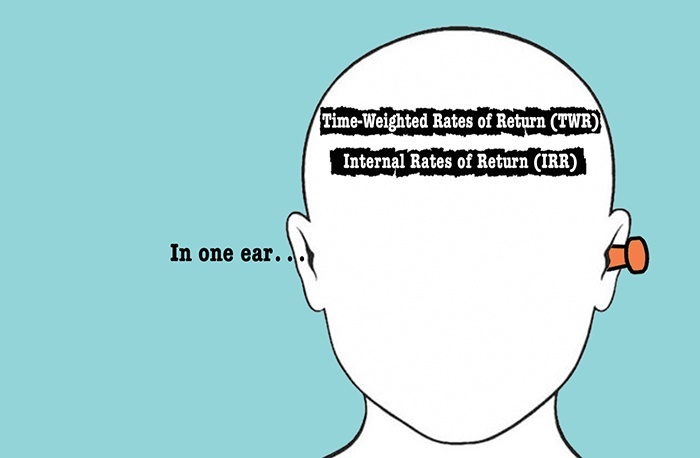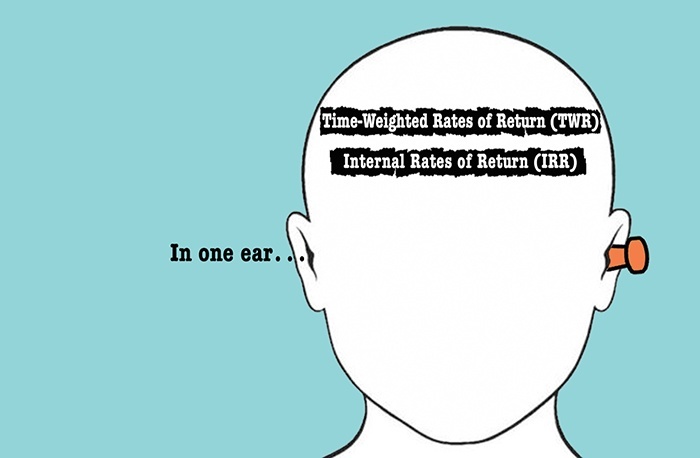
Weird Words, Worthy Ideas: Time-Weighted vs. Internal Rates of Return

If you’ve been reading our blog posts for a while, you know that we try to avoid financial-speak whenever possible. But until the rest of the world follows our lead, sage investors are best served by familiarizing themselves with two weird, but worthy terms: Time-Weighted Rates of Return (TWR) vs. Internal Rates of Return (IRR).
We’ll explain what we’re talking about in a moment. But first let’s talk about why it matters. Just as you can measure someone’s height and weight for varying reasons, TWR and IRR measure two different dimensions of your portfolio’s returns, with two very different reasons for doing so. Confuse one with the other, and you could end up believing that your portfolio needs to go on a high-fat diet so it can grow two inches taller.
In other words, even if a data point is correct, you can readily misapply its meaning. That’s why it’s worth knowing what TWR versus IRR measurements really mean, and when to use them for what within your investment experience.
TWR: Your “Apples-to-Apples” Return
In a world where checks and balances matter, you and your advisor want to have a reliable way to assess how your portfolio performed compared to appropriate benchmarks during particular periods of time. During any given period, did you and your advisor do a good job of creating a portfolio mix for delivering acceptable returns, given the amount of risk you took on? That’s where the Time-Weighted Rate of Return is a good tool for the job.
We’ll spare you the precise math involved, but your portfolio’s TWR calculations are designed to isolate the returns resulting from your portfolio’s make-up and minimize the impact of other factors – especially cash moving in and out of your accounts according to your financial goals. The calculations are made by taking small interval chunks of your portfolio, typically a month at a time, and linking them together geometrically to come up with a relatively accurate measurement as described. To further improve on the apples-to-apples comparison, we like to see TWR returns reported net of any advisor fees.
Consider, for example, 2005–2014, and the myriad global events that occurred during that timeframe. TWR lets us measure the performance of your portfolio’s unique investment make-up during the decade – Great Recession, subsequent bull market and all – and appropriately compare it to other risk-adjusted returns being reported during the same period.
IRR: Your “Where You Stand” Return
While the TWR is useful for assessing the performance of your precise portfolio mix in isolation, it does not necessarily inform you of where you stand in relation to achieving your overall financial goals. For example, say you’re investing toward your kids’ college funding, and you want to know where you stand, near or far, toward achieving the raw dollars needed for the goal.
For that purpose, your portfolio’s capital inflows and expenditures and their impact on your absolute returns become relevant. The IRR becomes the measurement of choice for this sort of financial planning, because it’s designed to measure how the portfolio’s investments did overall.
Calculating the IRR involves bootstrapping results based on an initial guesstimated return and then adjusting and reiterating as often as necessary to arrive at the most accurate data point. You might compare the process to that of an archer shooting at a target, adjusting his or her aim from the initial shots until hitting the bull’s eye. Needless to say, the calculations are best made with robust software optimized for the role.
The Meaning of the Measurements
While we’re not suggesting you pursue a degree in mathematics to get a handle on your relevant returns, we do believe it is worth knowing when to use which measurement – TWR vs. IRR – especially if you’re using it to make follow-up financial decisions. If your investment performance reports don’t specify which return you’re viewing, it’s a question well worth asking. If they do specify, but you’ve always wondered what the terminology really means, now you know!
 Sage Serendipity: While most of us don’t miss our high-school math class struggles, this post is case in point that arithmetic can be your friend. To celebrate more math, more often, we suggest giving Math for Grownups a “Like” on Facebook. Who knew math could be so fun?
Sage Serendipity: While most of us don’t miss our high-school math class struggles, this post is case in point that arithmetic can be your friend. To celebrate more math, more often, we suggest giving Math for Grownups a “Like” on Facebook. Who knew math could be so fun?
 Secure Document Sharing
Secure Document Sharing


